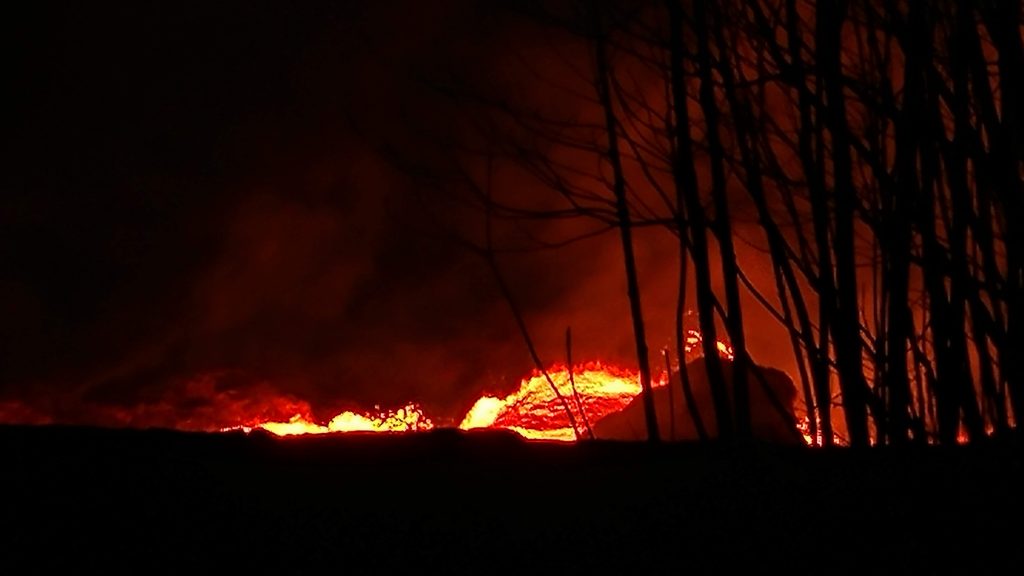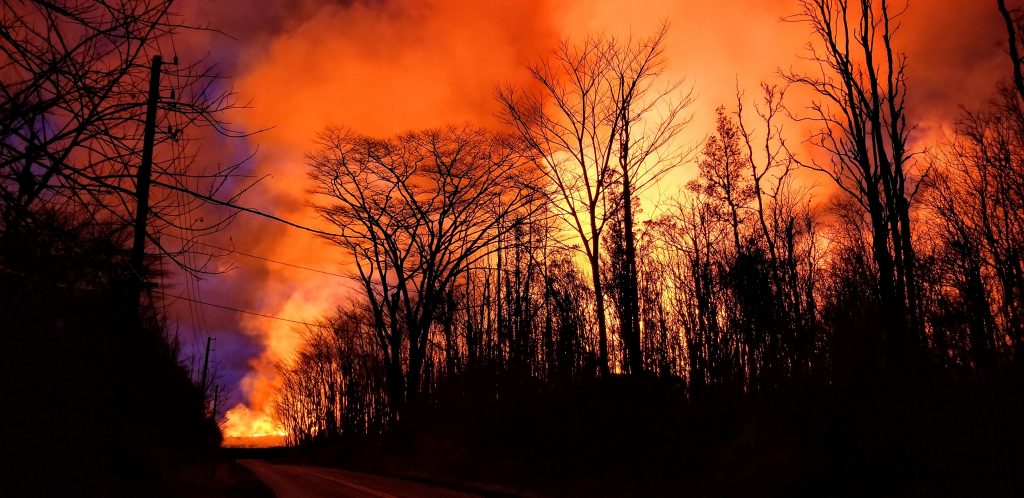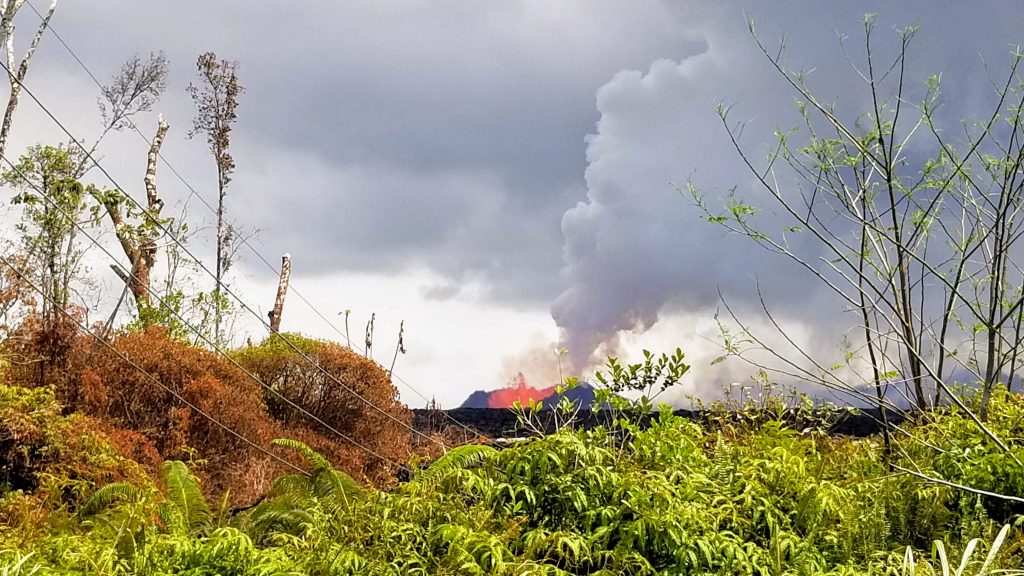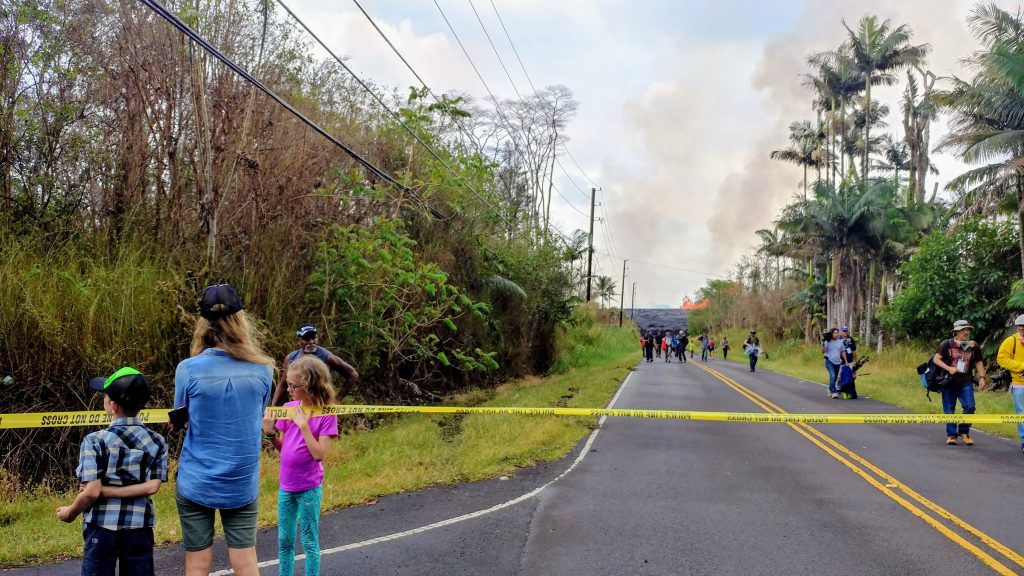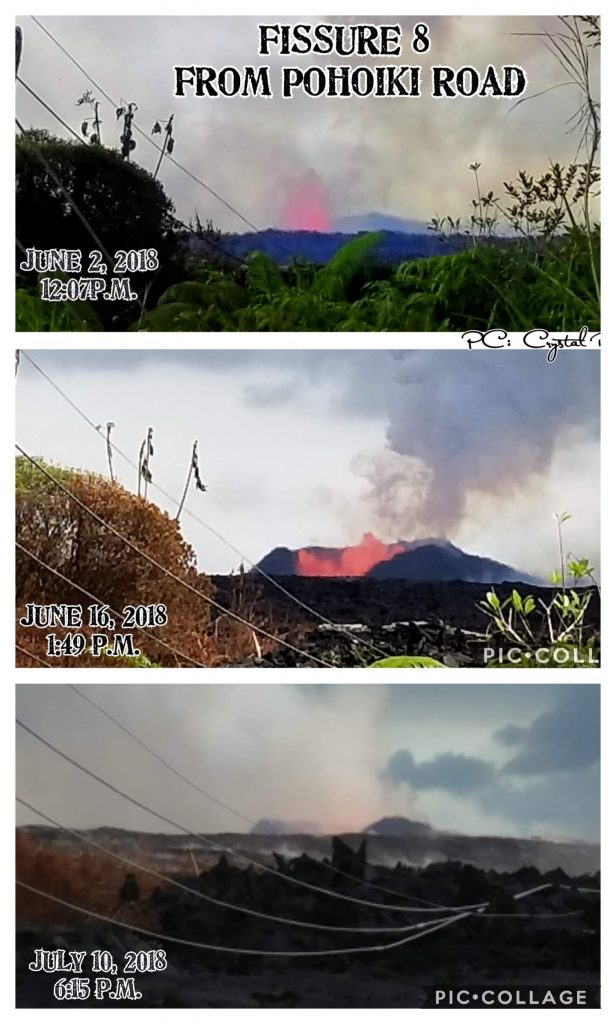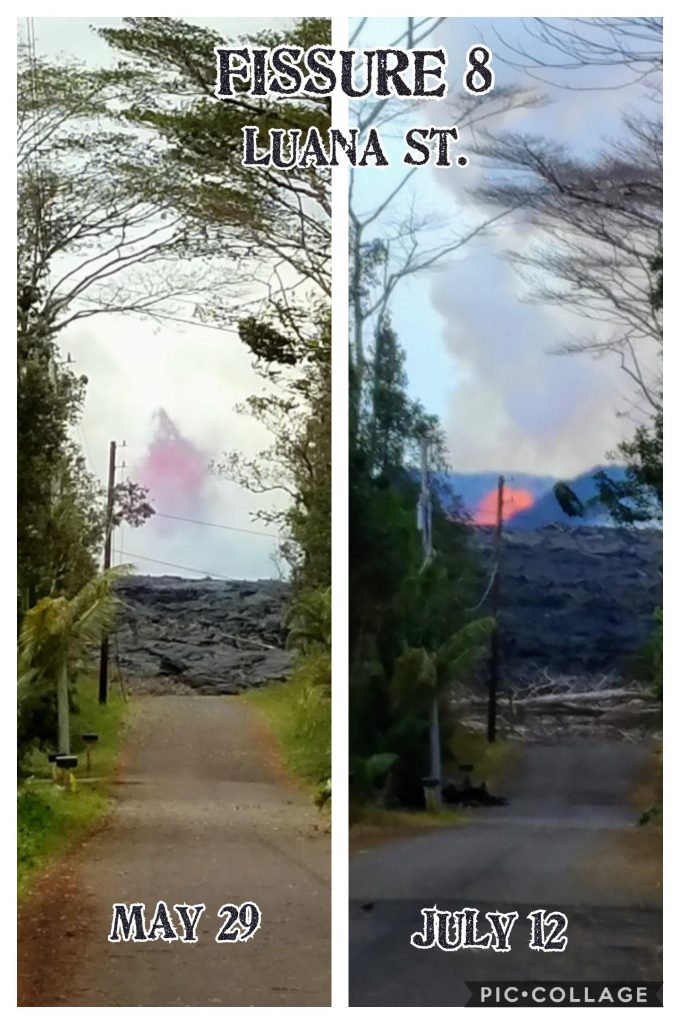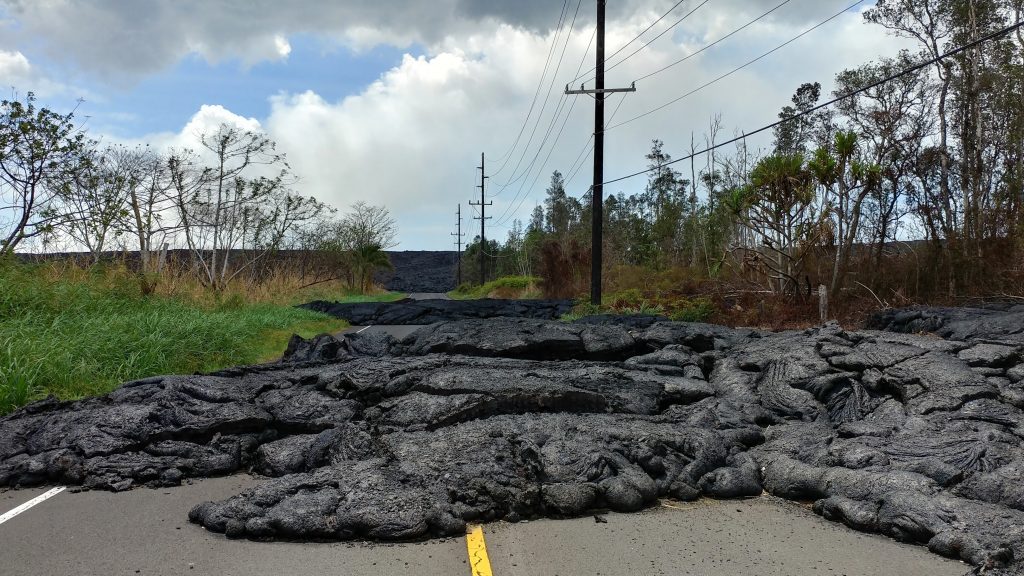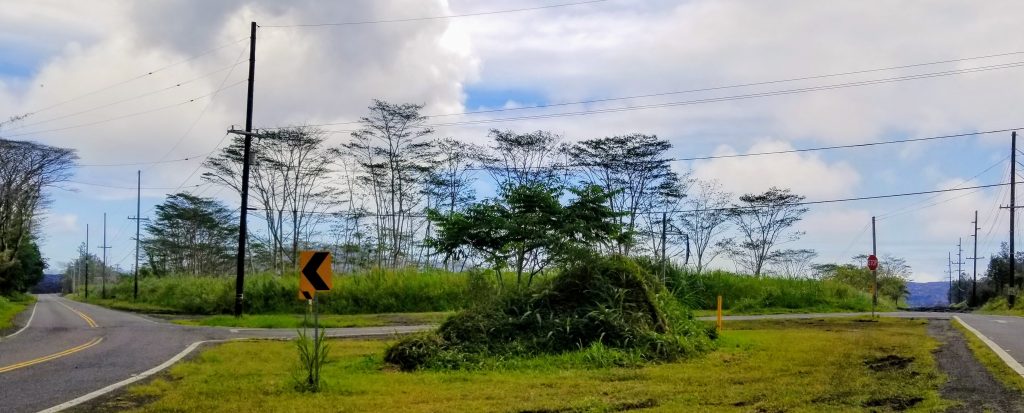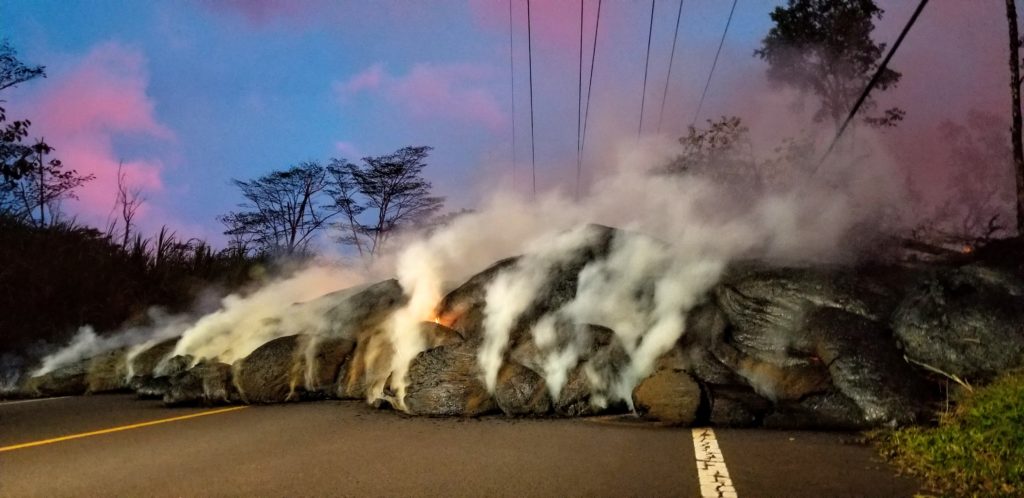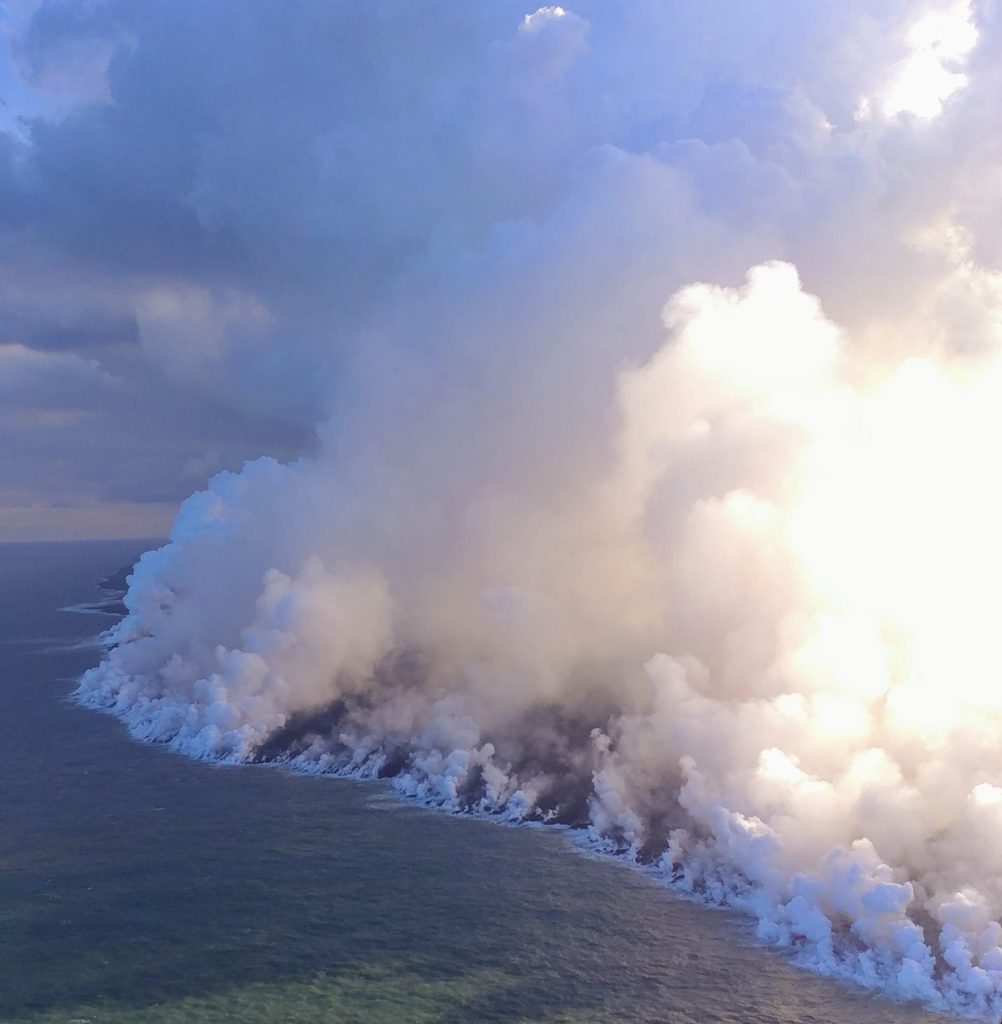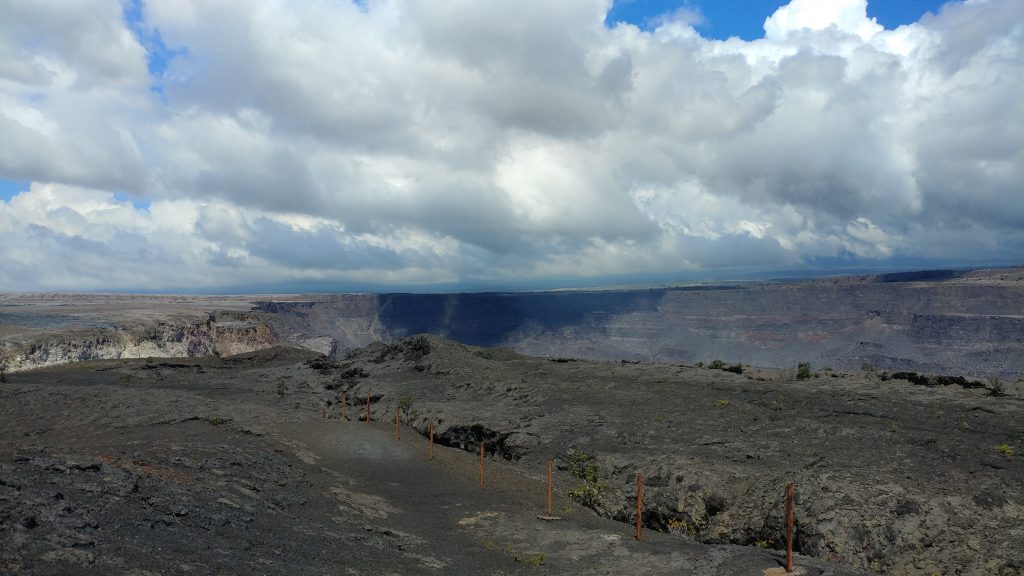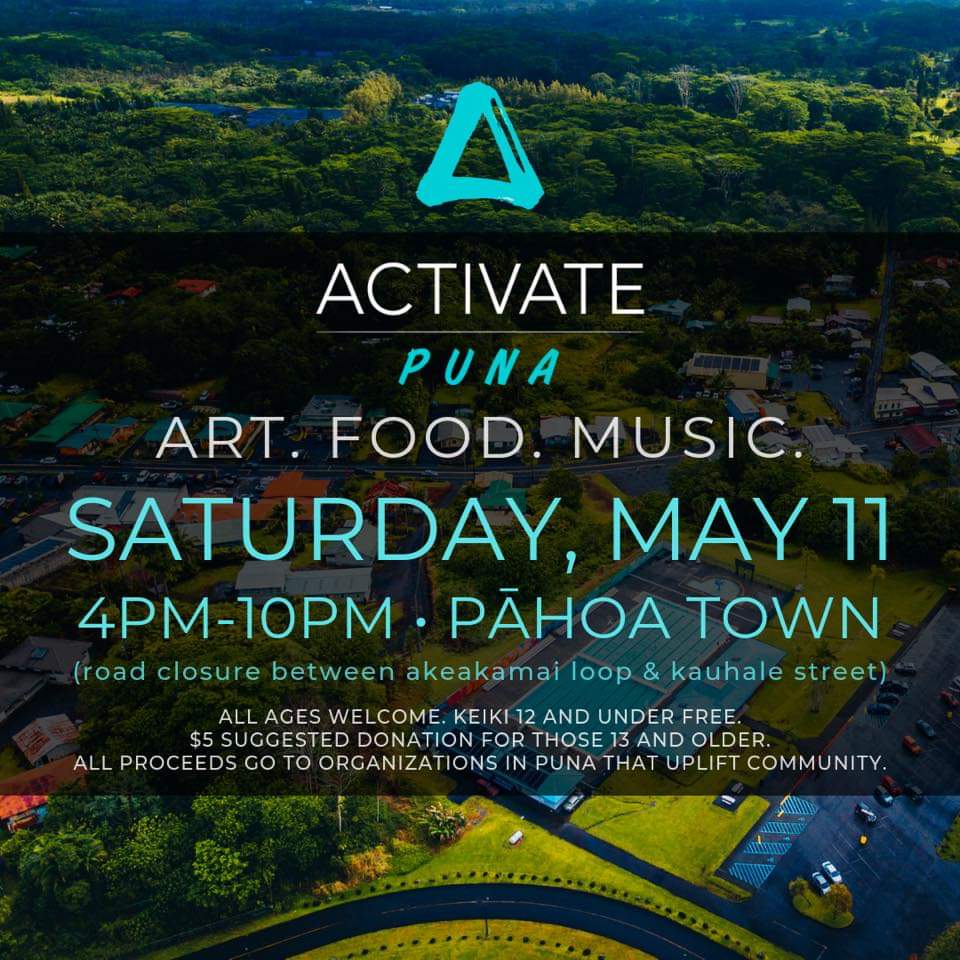Finding a Silver Lining: One-Year Kīlauea Update
May 3, 2019, marked the one-year anniversary of the start of Kīlauea Volcano’s 2018 Lower East Rift Zone eruption on Hawai‘i Island.
Although the eruption ended over eight months ago, recovery widely varies depending on location and extent of impacts.
In Leilani Estates, where the lava first surfaced on May 3, 2018, recovery looks different for everyone.
Over the next few months, a lava river would form, wipe out centuries-old tidepools, warm ponds and over 700 homes.
In 90 minutes, the state’s largest lake, Green Lake evaporated and filled with lava.
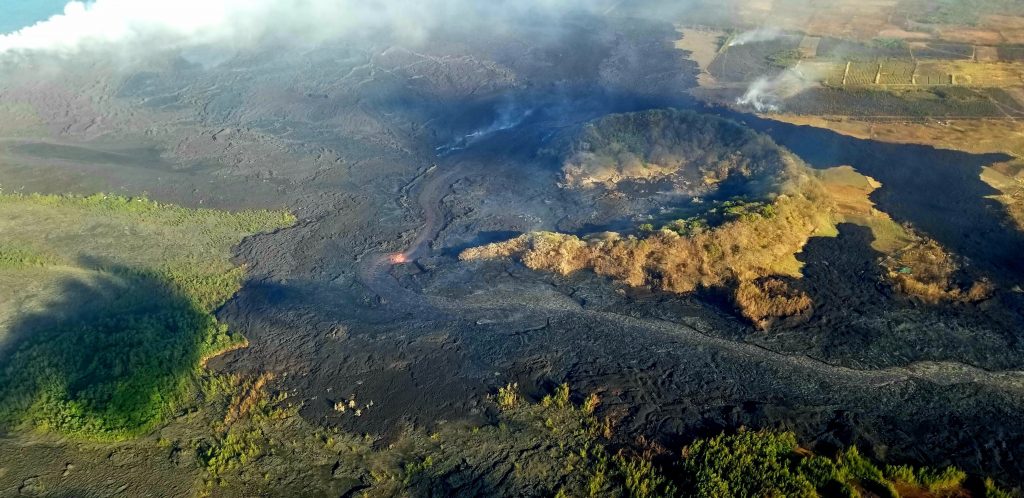
Green Lake filled with lava, evaporating one of two fresh water lakes on Hawaii Island, seen on July 8, 2018. PC: Scott Cate.
Countless pets, livestock and wildlife such as pigs and sea turtles lost their lives.
Over 2,000 residents were displaced. Some moved from the island, unlikely ever to return, while others stayed as long as they possibly could and are now attempting to return to life in Lower Puna.
The 2018 Kīlauea Eruption was an unprecedented 100-plus day eruption disaster that occurred on the Island of Hawaiʻi between April and September 2018 and stopped on Aug. 5, 2018.
There is a strong sense of resilience and strength in the Puna community as the one-year anniversary approached.
Just like the eruption impacts vary from person to person, so does recovery.
The needs vary widely. All are looking for healing and a way forward.
Mick Kalber, videographer and president of Tropical Visions Video Inc., had a unique experience and perspective of the historic eruption.
“This eruption caused a gambit of emotions,” explained Kalber. “At first, it was exciting to see what was going to happen, but then it got scary. I was flying every day, so to an extent it was taking my mind off of it, but I am going up there and seeing my house right next to the river.”
Flying nearly every day to record the eruption activity, Kalber was able to keep himself busy, but he said he couldn’t take the stress of worrying about losing everything.
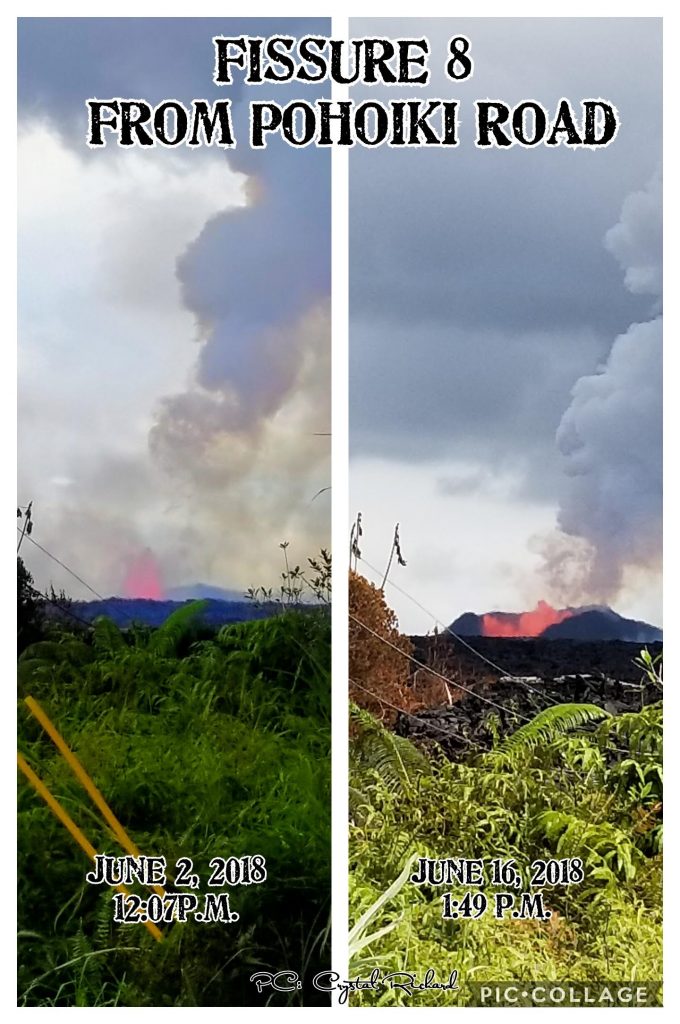
Fissure 8 from Pohoiki Rd. PC: Crystal Richard.
“If the volcano takes our house, she takes our house. There’s nothing I can do about that, but I do have the option of removing our possessions,” explained Kalber.
He said that once he and his wife, Ann, moved their belongings from their Leilani Estates home, he was relieved and able to focus on documenting the historic flow.
He shared that during the eruption, there were only a few times he felt anxious or fearful of what might happen.
“When Fissure 8 formed, we hadn’t been flying for a few days,” explained Kalber. The weather had kept him and his colleague photographer, Bruce Omori, away from it.
He said, “All of a sudden when we finally get there, there is Fissure 8. It’s running a river.”
That river, nine miles long, was running parallel to the Kalbers’ street.
The Kalbers’ home sits a half-mile from Fissure 8 and was a quarter-mile from the river.
It became a waiting game to see if their home and dream property would survive.
With each surge and spillover, the possibility of losing it was reinforced.
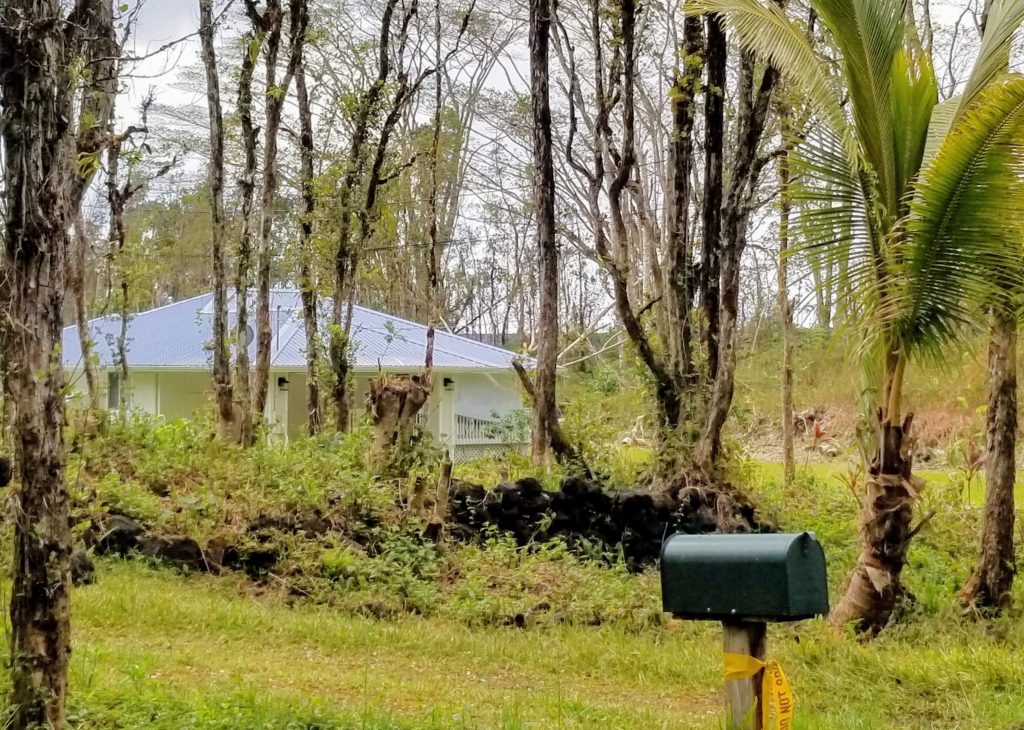
Yellow emergency tape on a propane tank gate post on Luana Street in Leilani Estates, after emergency officials mark homes that have been evacuated, on May 30, 2018. PC: Crystal Richard.
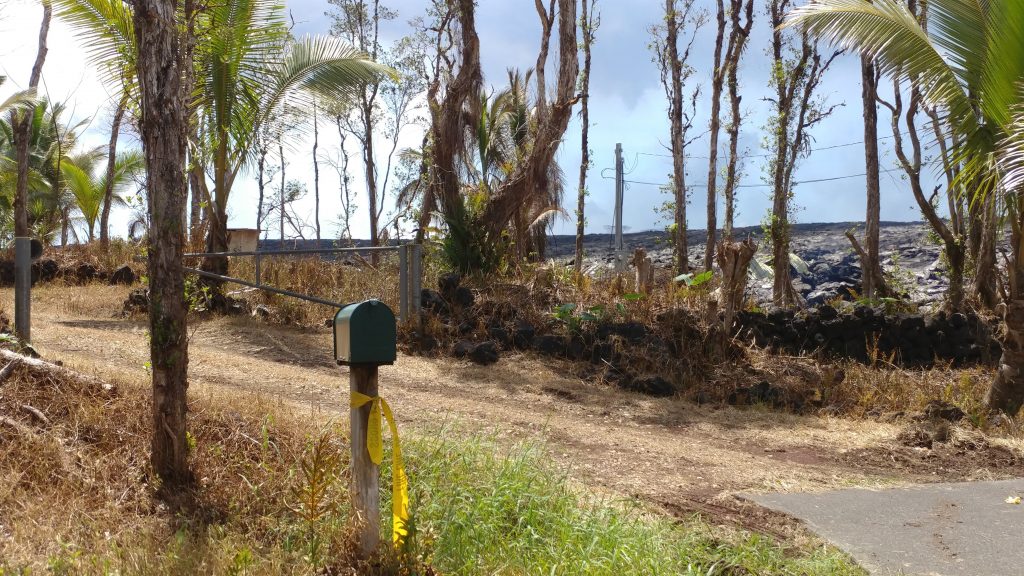
The Leilani Estates home seen above, was lost due to spillover from fissure 8 on July 12, 2018 in Leilani Estates Subdivision in Puna, Hawaii. PC: Crystal Richard.
“There are so many people out there with houses, some within 6 feet or a yard of the flows. Some are salvageable and some are not because they are that close,” explained Kalber. “We got lucky.”
The Kalbers are now back home in Leilani Estates living their “new normal” and investing in their property, replacing the rusted roof, carpets and fixtures damaged by SO2.
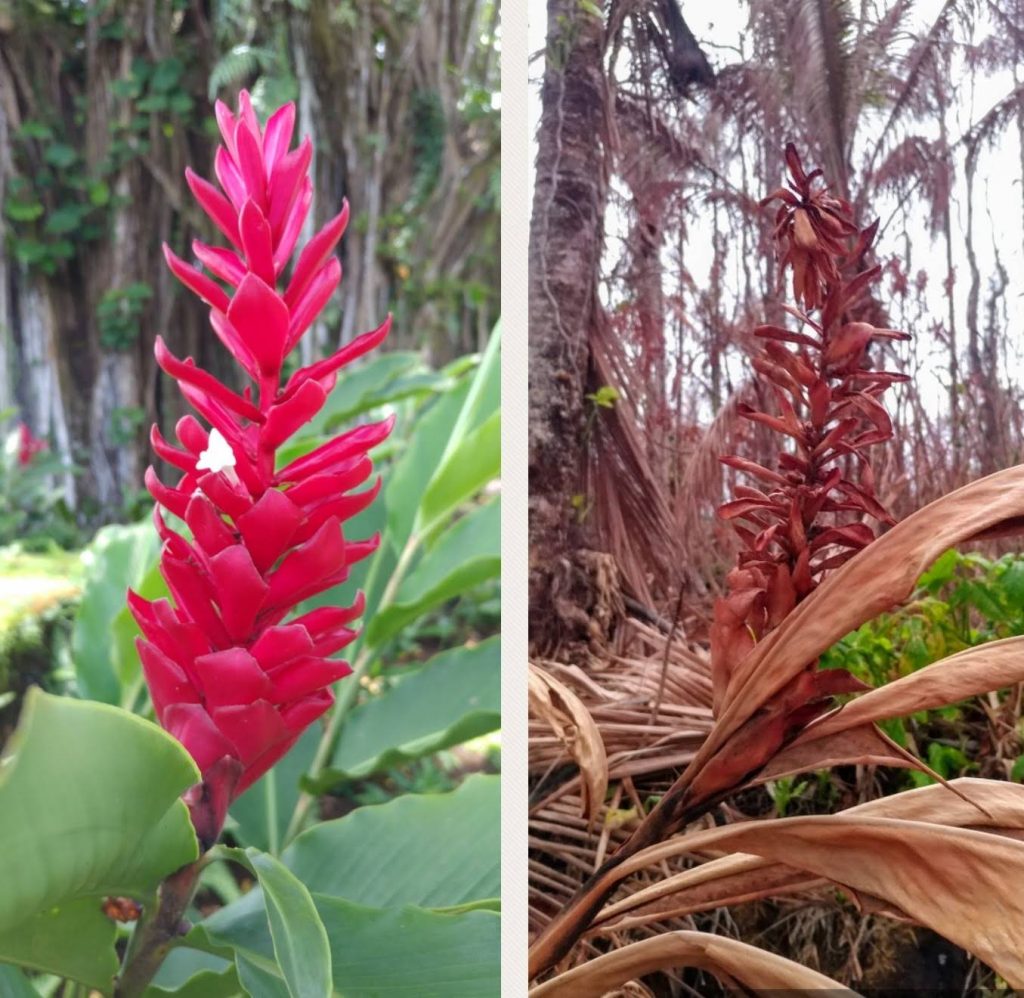
Red ginger after effects of Sulfur Dioxide emissions during the Kilauea Eruption in the Lower East Rift Zone in July 2018. PC: Crystal Richard.
Others in Puna were not as fortunate as the Kalbers.
Roxanne Estes, a certified nurse midwife, advanced practice nurse practitioner and owner-operator of East Hawaii Midwife Service, lost her place in Leilani Estates.
Estes delivered the Kalbers’ granddaughter, Iris Kalber Ingram, at her beloved birth center known as Luana Gardens in Leilani Estates.
“Where my land was is a very large crater that is Fissure 8, until there is another name for it, in humor my husband used to say, ‘Sam & Roxanne went to Hilo and left the lava on… we are sorry.’ But all kidding aside, we did walk out to see if there was any trace of our lives out there and there is nothing… 25 years of possessions and living—all without a trace. My husband also lost his Nepenthes farm and greenhouses. He was a renowned breeder to rare nepenthes plants of which he lost about 10,000 plants.”
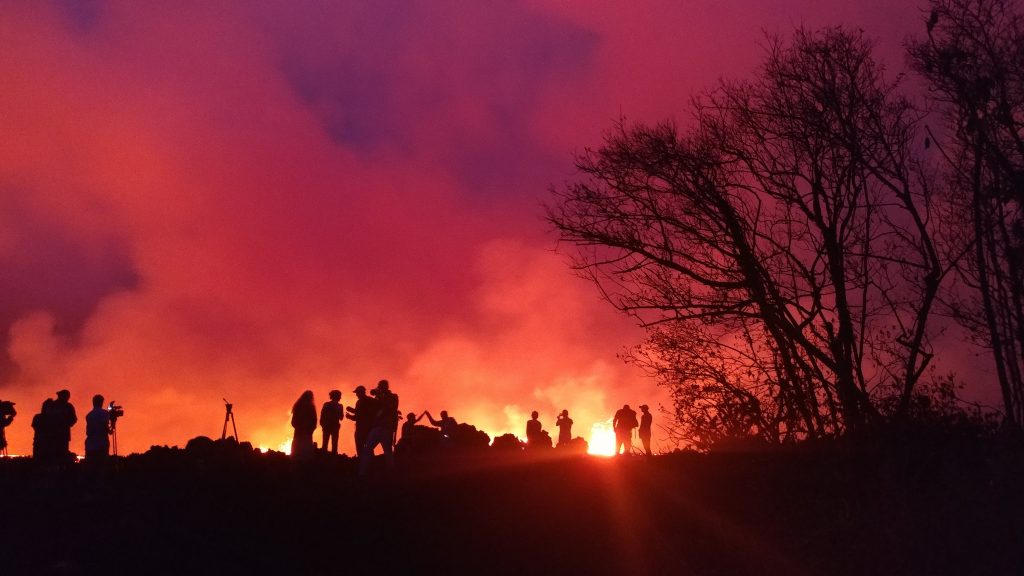
Members of the media and Leilani residents documenting the historic 2018 Kilauea Eruption on May 24, 2018. PC: Crystal Richard.
When asked what the hardest part has been, Estes said, “Personally, having faith that things will get better. It was just so hard and unexpected. One day everything is in order, then bam, I lost my home and my business. I had to quickly shift my business into high gear to maintain my practice and the commitments I already had. I had several mother’s due at the time with birth plans drastically altered. Women and mothers are amazingly pragmatic and will do anything to protect their families. We helped women make their plans. Some moved away to the mainland, some transferred to planned hospital births, several continued their out-of-hospital birth plans and prepared to birth at relatives’ homes, friends’ homes, air B&Bs—and we even had a hotel birth. We spent a lot of time processing medical records for transfer of care and preparing for impromptu home births. I really did not have much time to consider my own situation until several months later—and then it hit very hard. The loss was just so much.”
She said they have suffered great financial loss, as most businesses in Pāhoa have, due to young families either moving away or relocating to other parts of the island.
“We really miss our Birth Home, affectionately called ‘Luana Gardens,’” Estes said, “but it seems Pele had other plans to it. Luana Gardens was a lovely spot where community women gathered to share birth stories, support each other during their pregnancies, learned breastfeeding techniques and new baby care along with a very special place to birth. Walking into Luana Gardens was like walking into your grandmother’s house with soft furnishing and pictures on the walls. Outside there were nurturing pathways of scented flowers and fruit trees with absolute seclusion for women to fully express themselves in labor. We held a gathering of the mothers and babies that have been born at Luana Gardens to say goodbye. This is a place very dear to the families that birthed there.”
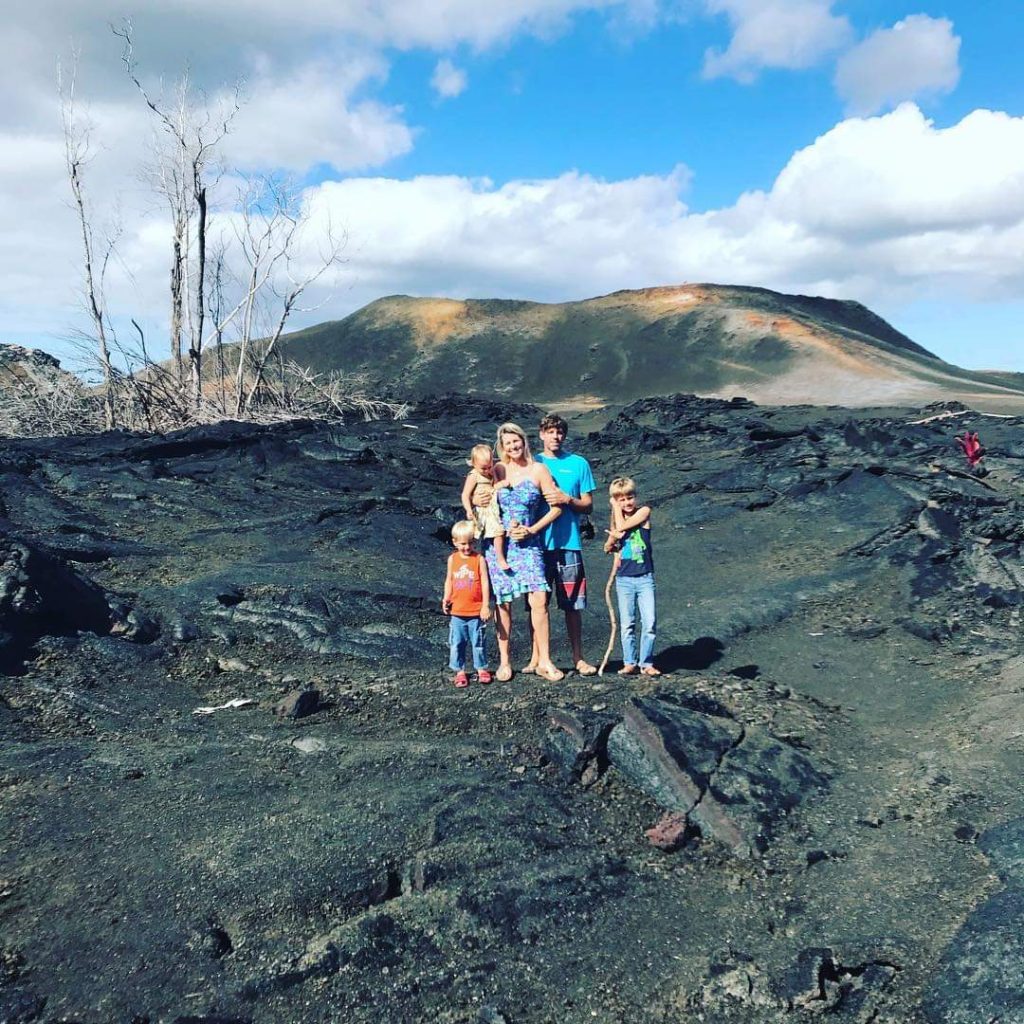
Wynn Miller, Ivory Kalber holding Iris Kalber Ingram, Alex Miller and Tay Miller standing 100 yards from where Iris was born in Leilani Estates at what was Luana Gardens. Courtesy photo.
“I personally had to let it go for my own health,” Estes said. “I spent many days sitting in the middle of the burned-out wreckage that was Luana Gardens, lamenting the loss of a heartfelt dream. It seemed fitting that the mothers, babies and children birthed there helped my say goodbye for good.
Estes says some say they gave the place back to Pele.
“I wonder if she was looking for a midwife and the perfect place to birth her new land and decided that this was her birth place,” said Estes.
Some say that’s how legends are started.
Estes said in the Puna area, women are very isolated and many are suffering from post-eruption stress, including relocating their homes.
“Several of us, including myself, are still working with the disaster relief FEMA and Small Business Administration and are not fully restored with our housing,” said Estes. “Finding a new gathering or meeting place is on the next agenda so we can once again provide childbirth and lactation classes.”
When asked if there has there been a silver lining, she said, “I have been truly amazed at the community support that we received. Friends, community members and family came out of the wood work to provide support. When we finally got a rental house, within a day, an empty house was full of donated furnishings, linen and cookware. It was amazing, I will never forget how our community came together. FEMA and SBA were another story, though helpful and always kind, the paper work was atrocious as we lost all our personal files in the lava flow. Also, each visit to the FEMA station was a sad reminder to what we had lost, mostly I left there in deep sadness. To date, we have not received any FEMA funding however we have been reassured that funding of an SBA loan is on the way any day now. Silver lining… that our community is resilient, we help each other in times of crisis. In Puna and the Big Island we do not wait for government help we help each other, this is profound. They say we are ‘Puna Strong’ and I believe it.”
Estes shared that when she showed a visitor what was her home now Fissure 8, she mentioned it must have been terrifying.
Estes responded, “Well I have to say it was more awe-inspiring—Mother Nature at her wildest. Every day was a different experience; the numerous earthquakes, the fountaining eruptions, the demon-like sounds coming from the Earth, the continuous bombing-like sounds coming from deep in the Earth, the red sky, the sulfur smells and people resorting to wearing gas masks in town. Just mind-blowing—every day was something new. I will always feel grateful to the boys out in the field who bravely kept us informed through fly-overs, drone footage and boots on the ground, as us residents were not allowed in our neighborhoods. The wondering and waiting for news of our homes was excruciating. We all became amateur volcanologists as we sat by our computers just waiting for each update. It was an exciting and sometimes terrifying time. We were all spellbound.”
“Getting back on track is my mission,” said Estes. “The sadness is less now; acceptance is coming. Yes, we lost our home, possessions and livelihood, but move on we must.”
When asked what she hopes to see happen in recovering Puna, Estes said, “I hope families that have relocated due to the lava flow will start moving back. Some have and the reunion of friends has been heartwarming. I see other new families still moving here as the costs of homes are very affordable. I would like to see more subsidies for the struggling business owners, many businesses in Pāhoa have taken financial losses. We are a strong community and many of the business even with their losses will continue and just due with less as they love their community and most of us can think of no better place to live in the world.”
Another resident who lost her home but is hopeful and on her way to healing is Shana Ritsema of Lanipuna Gardens.
For her, not being able to see her property has one of the hardest parts. Ritsema is among residents who have either no access to their lava-covered property or who cannot access their isolated homes.
“I have not been able to access my property yet,” explained Ritsema. “It is in an area that is hard and dangerous to get to. I really want to be able to see it again at some point and that has been the hardest thing, not being able to see it yet. I have to either get permission from my neighbors and hike over the lava about 45 minutes from Leilani-side or wait till they bulldoze Pohoiki Road.”
She said she is very grateful for their new place in Hawaiian Paradise Park and is hopeful she will keep healing from the loss and move forward.
“It’s so funny, but I remember a FEMA worker asked me how long it would take to recover from the disaster, and I said probably a year—and soon it will be,” stated Ritsema. “I do feel like I am getting more to that stable place. It’s been an extraordinary experience.”
For Ritsema and those among the former residents of the 700 homes completely buried and lost, recovery has been a process of accepting what you cannot control or change.
Among those is Susie Osborne, head of Kua O Ka La NCPCS, home to 250 pre-K to grade 12 students.
“It has been a difficult year for me. I have struggled with health issues such as lung problems due to getting gassed from SO2 when trying to rescue my cats, lack of sleep and high stress from the uncertainty we had from our insurance being denied,” explained Osborne. “Lots of PTSD. When the insurance did finally come through, I bought a home in January and this has really helped to stabilize me and let the healing truly begin. It will take time and support.”
For Osborne, part of creating a new normal included finding a place to swim and work out. She said this has really helped.
Kua O Ka La is now located at the Nani Mau Gardens in the Panaewa area and their office is in downtown Hilo.
“There is absolutely no access to my home or my school—only miles of lava… no roads exist to either site,” explained Osborne.
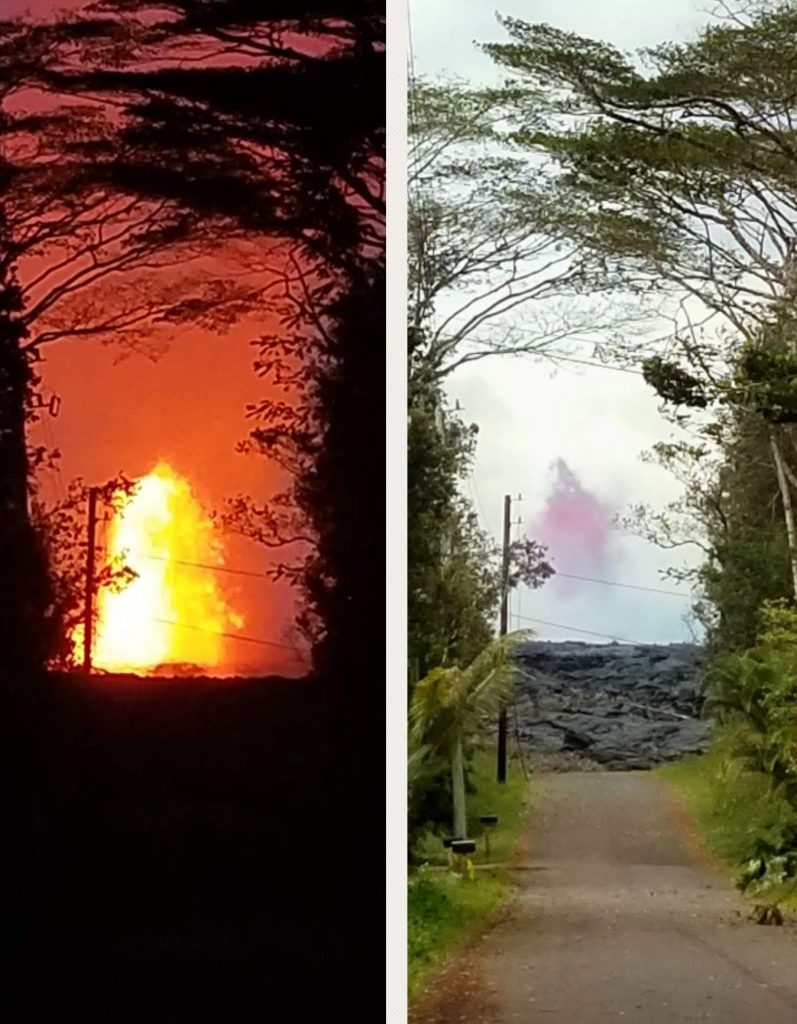
Fissure 8 on May 29 and 30, 2018, from Luana Street in Leilani Estates Subdivision during the Kīlauea Eruption in the Lower East Rift Zone. PC: Crystal Richard.
For Osborne, the hardest part was being denied by insurance and the trauma that caused her on top of all the loss, and sadness.
“This really made me fearful, anxious, depressed and not able to sleep,” said Osborne. “For the school, it is the fact that the state did not step up to help us. We are working with Hawai‘i County to secure some of the $60 million that is dedicated or disaster relief, but no commitment has occurred yet and we have not received any funding support that we really need. We really need help with the current county compliance for our current facilities and for the future, we need a permanent campus. A school is a critical infrastructure. Our families lost their homes or were displaced and lost their beloved school. It’s a double whammy.”
She said the county is considering providing some funding help for planning for a new campus, but Osborne is not sure how they will build or buy a facility.
“This is a critical part of our healing,”said Osborne. “Having our own campus, like having a home. The community coming together to help us is the silver lining. Five East Hawai‘i Rotary Clubs came together and raised funds and brought manpower in to do a makeover of the Nani Mau facility in preparation for our students. We call it the ‘Miracle at Nani Mau!’ Makana did a concert for us and so many community organizations and individuals stepped up to help us, donate school supplies and funds so there were no costs for our students such as school uniforms. All donations went immediately in addressing student needs. This was all a silver lining! We are filled with gratitude for that support!”
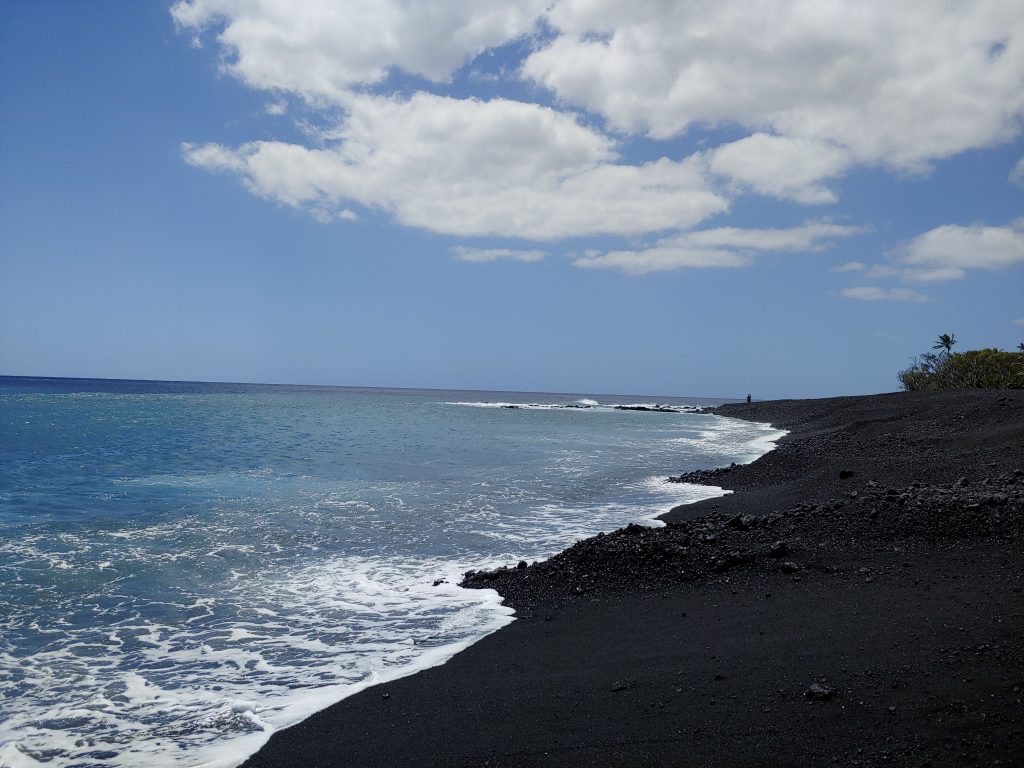
For some, a silver lining from the eruption is the new black sand beach at Pohoiki Beach in Lower Puna, on March 18, 2019. PC: Crystal Richard.
Osborne says she holds a great vision for a future campus.
“Our school was the first totally solar run school in the state of Hawai‘i. That was good, but we feel we can do so much more. We are a Hawaiian focused charter school grounded in Hawaiian values and place-based learning. We want to create a learning environment for tomorrow, supporting 21st century learning skills, innovative research and development, a pilot for cutting edge technologies in environmental, digital and other technologies that align and support our mission. We feel like we can honor traditional practices while preparing and supporting our students in total wellbeing and enlightenment! We send the call out to all the nation and world to join us in this endeavor including being part of the dream team, planning and funding in order to do something great for the next generation. This should be where our biggest investment in this recovery is.”
“It has been full of ups and downs,” explained Osborne. “I have tried to stay present and not dwell in what is gone. Loosing two of my cats fills me with grief and that is hard. I have faith in the future and am full of gratitude for all of my friends and family that have supported me during this really difficult time. I really have struggled with resulting physical and mental health issues and had to put serious resources and attention on getting healthy and back to a place of balance.”
When asked she feels about the response to the disaster and the recovery efforts, Osborne said, “I have a lot of mixed feelings about the response. The Hawai‘i County Civil Defense office and transportation division really stepped up to help us evacuate the school. They were fabulous. The general communication from Civil Defense was poor. We needed real-time information about the lava and this all happened from community groups. In 2014, when the lava threatened to take Pāhoa Town and some DOE schools were threatened, the state emerged to help relocate those schools. They harnessed all resources and manpower in their support, including setting up portable classrooms. These are public school children. None of this happened for us. Charter school students receive no facilities funding and there is no disaster support funding in place for charter schools.”
For others, moving forward and creating a new normal has been more difficult. For some, they have been living in limbo waiting to get back to their homes and farms.
Kipuka resident Lisa Roach’s property sits inside a landlocked area of Highway 132. A kipuka is a pocket of land isolated by lava flows.
“I do see that this eruption is an opportunity for this island,” explained Roach. “It is a graveyard, yes, but it is lined with silver. And obviously we can’t go backward, so we should do the best with what we have. The opportunity I see is that the kipuka—yes, my land and incinerated home is there—should be home to farmers who can take advantage of the ideal weather. There is much land to reclaim. Many landowners are doing what they can to reclaim with the limited access that is currently allowed. But most residents realize that this all takes time. And most seem to be very resilient types. I’m proud to be their neighbor.”

The photo is from August 2018 when Lisa Roach flew in with several neighbors. She spent several days and then returned every three weeks to spend two to three days doing minor cleanup and weeding. The fire was on July 28 or 29, 2018. Courtesy photo.
Roach said after the fire destroyed her property during the last days of July of last year, about 50% of her trees have re-sprouted from the roots.
“I’m looking forward to rebuilding my home and reclaiming my orchard and garden beds,” said Roach. “The pigs have been a huge problem that we continue to tackle. But the med fly, many fire ant colonies and the semi-slug and other rat lungworm carriers were wiped out for a time after the eruption due to the SO2 and the wildfire… an example of a silver lining.”
She also shared a story of her cat Balzy (short for Balzac).
“I had two cats that I brought food to and they were both there until my fourth trip out, when I found that the other boy had disappeared, so I evacuated Balzy with me by helicopter when we were ferried by our wonderful helicopter pilot David Okita. One of my neighbors took two of his out the same day—one in a zip-up cooler and another in a bucket. I put Balzy in a tiny trashcan with a lid and he did not like it one bit! But he’s happy now.”
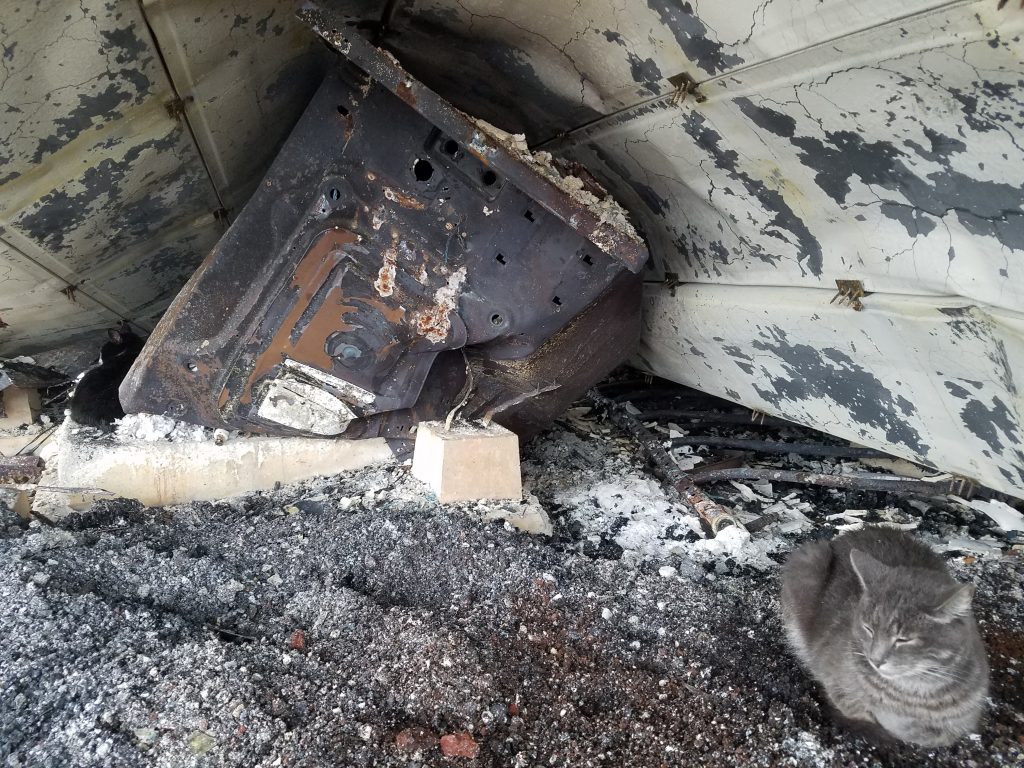
Balzy, Lisa Roach’s cat, survived the fire and was safely evacuated by helicopter during the 2018 Kīlauea Eruption. Courtesy photo.
Another resident with a 13-acre farm inside the kipuka is Nancy Seifers.
Seifers returned to teaching at 70 years old in order to pay the mortgage she took out on a home she purchased after evacuating her home off Highway 132.
The eruption cut off Pohoiki Road and then Highway 132 in late May 2018.
Nearly a year later, residents are accessing their isolated homes through what Seifers describes as a “very temporary, rough road.”
She said the residents in the area have collected funds and spent over $7,000 in just three weeks maintaining the road the easement road provided by Puna Geothermal Venture.
She said by day three, the road was almost completely washed out, requiring cinder to be trucked in. She wants to emphasize how important it is that the disaster relief funding go and stay in the area of the disaster.
She pointed out concerns over disaster funds going to other places because of the impacts on tourism due to the eruption.
“We don’t want to be forgotten or dismissed,” stated Seifers.
“Just listen to the people,” she pleaded.
Seifers said in the Highway 132 kipuka there are 57 homes, farms and properties, which accounts for hundreds of people between partners, children and farm workers.
Many are particularly concerned over getting farmers back to work in the area.
The brush fire that was caused by lava flows, which burned down houses and structures in the kipuka off Highway 132, also took Seifers’ home, but she has another building on her property.
In the last two weeks, she has replaced her water pump, purchased a new generator and erected a gate.
She said while they are very thankful for the temporary access through PGV, she said, “This is not the answer. We are appreciative, but this is not the answer.”
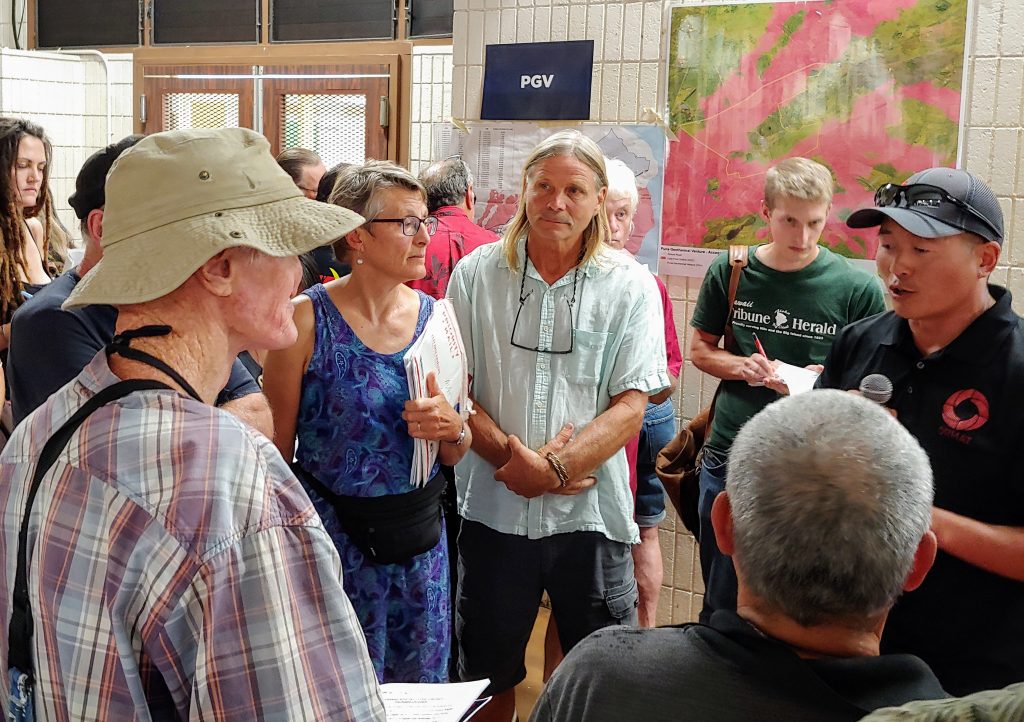
Puna Geothermal Plant Manager Jordan Hara answered community questions during the PGV meeting on March 22, 2019, in Pāhoa. PC: Crystal Richard
Seifers is among residents concerned over the pace of recovering access of Highway 132, as well as the cost to do so.
“Why couldn’t it be done cheaper,” asked Seifers.
She questioned why Hawai‘i County Mayor Harry Kim did not extend the emergency proclamation, so there would be no requirements for permits, surveys and talk stories.
The section of highway needed to restore access is a 1.6-mile section, but the lava flows are up to 70 feet high.
Mayor Kim said he was waiting six months before making any decisions. April marked six months since the eruption was considered over by scientists.
For many, roads are necessary to create a new normal.
On April 1, 2019, PGV opened a rough gravel access route for residents with homes inside a kipuka, but like Seifers pointed out, this is a temporary solution.
Prior to the road through PGV and landowner Lono Lyman’s properties, residents in the Highway 132 kipuka were hiking in over the lava flow or flying in.
Hawai‘i County Council District 4 Rep. Ashley Kierkiewicz expressed similar concerns over costs during a council meeting held April 24, 2019.
Kierkiewicz asked why it is going to cost between $37 and $40 million to be completed.
She pressed the county on plans for Highway 132. Public Works Deputy Director Allan Simeon said for the Highway 132 project, right now they are waiting for the grading permit process to be completed, as well as waiting for private owners to return forms giving them right-of-entry.
“There will be another eruption, but unlikely for some time, said Roach. “How do we prepare? How do we handle tourism? These are the million-dollar questions.”

An orange glow fills the night sky from the lava flow in the Lower East Rift Zone of Kilauea Volcano on May 29, 2018, on Luana Street in Leilani Estates on Hawaii Island. PC: Crystal Richard.
According to the Hawai‘i County Recovery website, the county is making progress toward reopening Highway 132, which was inundated by lava during the 2018 Kīlauea eruption.
The near-term goal is to reestablish access over a temporary road to homes and farms in the kipuka along Highway 132, including connections to Government Beach Road and Lighthouse Road at Four Corners.
Both temporary and permanent routes are being evaluated, with guidance from the Federal Emergency Management Agency (FEMA), the Federal Highway Administration (FHWA), and state regulatory agencies to ensure the county meets all necessary permitting and reimbursement requirements. The Department of Public Works (DPW) is working to complete temporary road construction before October 5, 2019 to qualify for 100% FHWA reimbursement.
Work In Progress:Updated March 15, 2019
- Preparing road construction permits, surveys, designs and cost estimates
- Aligning timeframes and requirements with FEMA and FHWA
- Sent right of entry letters to landowners abutting Highway 132 and Pohoiki Road to inform them of road construction that may require limited entry on their property
Estimated Schedule (Subject to Change)
- June-July 2019: complete Light Detection and Ranging (Drone) photogrammetry survey of the lava inundated roads
- Summer 2019: consultants complete an alternative study comparing and recommending permanent alternatives for Highway 132 as part of the federally-mandated NEPA process
- August-September 2019: complete permitting requirements for temporary road construction, including but not limited to the National Pollutant Discharge Elimination System (NPDES) permit, the National Environmental Policy Act (NEPA) Categorial Exclusion (CatEx) permit, Special Management Area (SMA) permit, and a grading permit which will be reviewed by DPW and State Historic Preservation Division.
- August-September 2019: complete design work for road construction
- September-October 2019: construction of Highway 132 temporary road contingent on meeting permit requirements.
Pu‘uhonua O Puna, also known as the Hub, is a place where residents could go for supplies, information, a warm meal and even a hug.
Evacuees could go to the hub and get almost anything they needed. Donations came in from all over Hawai‘i and the country.
An instrumental member of the Hub was Ikaika Marzo.
Marzo was on the ground looking at cracks developing around lower Puna on May 3, when the first fissure opened on Mohala Street in Leilani Estates.
Marzo went door to door notifying residents in the area an eruption had begun in Leilani.
He would go on to provide people with critical live updates and information throughout the eruption via social media. Ikaika Marzo is now a household name in Hawai‘i due to his efforts to help those impacted by the eruption.
District 4 Hawai‘i County Councilmember Ashley Kierkiewicz, a Pu‘uhonua O Puna volunteer, said the community-driven center raised over $200,000 via their GoFund Me.
Kierkiewicz previously addressed questions from the community over where the money donated will go.
“There have been some questions about the money we were able to raise via our Bank of Hawaii account and GoFund me,” said Councilwoman Kierkiewicz. “I am really proud to say we raised a little over $200,000 and that was parked in a recovery account.”

County Councilwoman Ashley Kierkiewicz during the Lava Disaster Town Hall in Pahoa, Feb. 23, 2019. PC: Crystal Richard.
She said the account only allows for one-way transactions; money goes in and that’s where it stays.
Kierkiewicz said the Pu‘uhonua O Puna board has discussed ideas but no decision on how the money raised would be used.
She said they have asked themselves are there sports clinics they want to do to empower kids.
She said they are also looking at ways to support Puna farmers.
To date, “The only money that has been given to date is the $30,000 that Ikaika Marzo and the captains of the Hub awarded to three families back in December who lost their homes,” explained Kierkiewicz.
The GoFund Me webpage says, “All money raised will go directly to residents impacted by recent lava activities.”
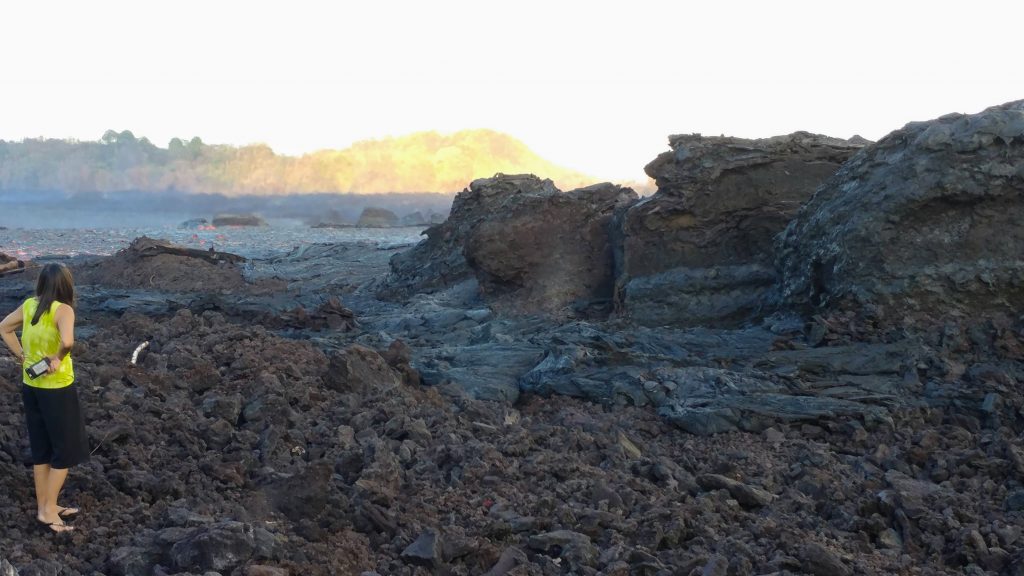
Puna State Rep. Joy San Buenaventura surveys damage to papaya farms and river from Fissure 8 on June 30, 2018. PC: Crystal Richard.
While the extensive impacts are seen and felt in Lower Puna, activity at Kīlauea’s Summit and impacts on tourism are still felt in Hawai‘i Volcanoes National Park and in Volcano Village.
HVNP continues efforts to repair and reopen trails and roads, assess and monitor unsafe areas, and welcome the public back to a landscape forever changed by last year’s epic volcanic activity.
Members of the park’s management team will share successes and challenges on the “Road to Recovery: One Year Later,” a special After Dark in the Park presentation on Thursday, May 9, at 7 p.m. in the newly upgraded Kīlauea Visitor Center auditorium. The event is free, but park entrance fees apply.
The historic Kīlauea eruption and caldera collapse of 2018 resulted in most of the park closing for 134 days last year due to unsafe, unpredictable and unprecedented eruptive activity at the volcano’s summit. A hurricane, two tropical storms and a wildfire on Mauna Loa added to the intensity of an unforgettable year, but park rangers continued to serve the public at locations outside the park, protect natural and cultural resources, and expand hours at the park’s Kahuku Unit. Most of Hawai‘i Volcanoes is now open, including two-thirds of the popular Kīlauea Iki Trail, but some areas remain closed for safety.
“We invite our community to hear first-hand how we managed the extraordinary challenges this eruption created, and what we face moving ahead,” said Acting Superintendent Rhonda Loh. “The presentation will be about a half-hour, and we welcome questions afterward.”

Halema‘uma‘u Crater after the Kilauea Eruption on August 17, 2018, seen from Jagger Museum in Hawai’i Volcanoes National Park. PC: Scott Cate.
Until 2018, Kīlauea erupted almost nonstop from two locations within Hawai‘i Volcanoes National Park: from the remote Pu‘u ‘Ō‘ō vent in the East Rift Zone since 1983, and from its summit crater, Halema‘uma‘u, since 2008. Pu‘u ‘Ō‘ō was renowned for producing surface lava that periodically streamed into the ocean, while Halema‘uma‘u hosted a dazzling lake of lava for nearly 10 years with glowing lava often visible from vantage points along the caldera rim. Many native Hawaiians consider Halema‘uma‘u the home of Pele, the Hawaiian volcano deity, and the entire summit area is one of the most sacred areas in all of Hawai‘i.
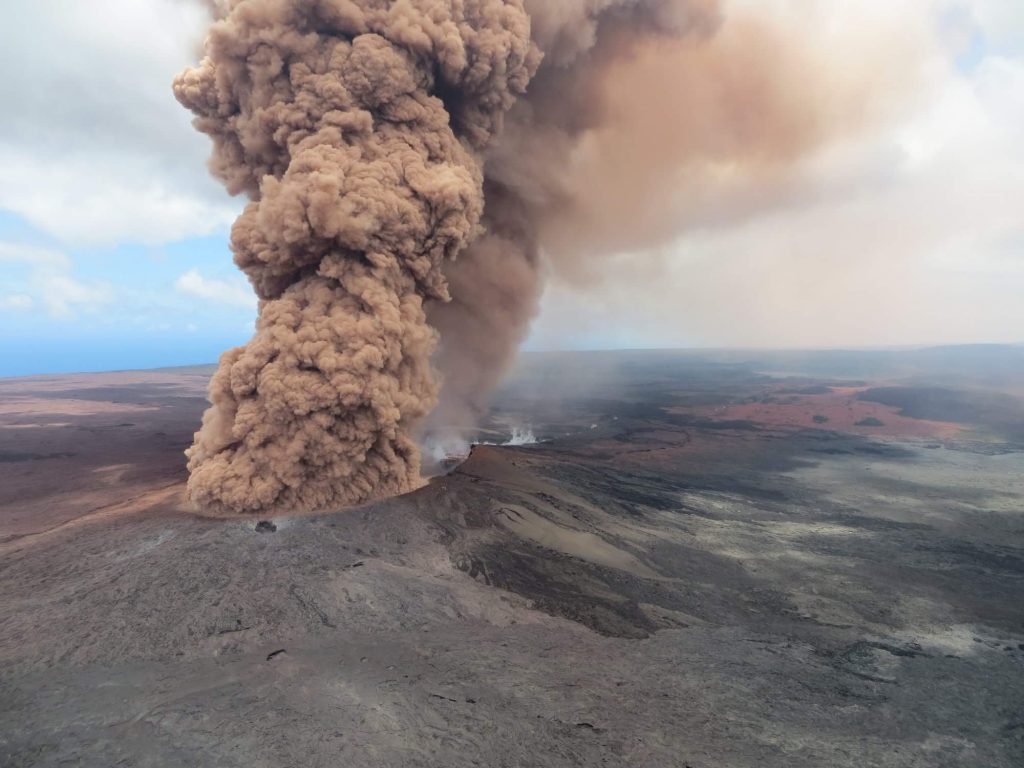
At 12:46 p.m. HST, on May 3, 2018, a reddish-brown ash plume rises after the magnitude 6.9 earthquake shook the Island of Hawai‘i. The ground shaking caused rockfalls and possibly additional collapse into thePu‘u ‘Ō‘ō crater on Kilauea Volcano’s East Rift Zone. A short-lived plume of ash produced by this event lofted skyward and dissipated as it drifted southwest from Pu‘u ‘Ō‘ō. USGS image.
On April 30, 2018, the floor of Pu‘u ‘Ō‘ō vent collapsed, followed by earthquakes (including a magnitude 6.9 on May 4) and movement of molten rock towards the lower Puna community. More than 700 homes were destroyed by lava, and more than 2,000 people were displaced.
At the summit, lava disappeared from Halema‘uma‘u and 60,000 or so earthquakes damaged park buildings, roads, trails, water systems and other infrastructure through the summer. Most of the park closed May 11, 2018 to Sept. 22, 2018. Currently, Kīlauea is not erupting, and there is no molten lava on the surface, but the volcano remains active and is closely monitored by scientists.
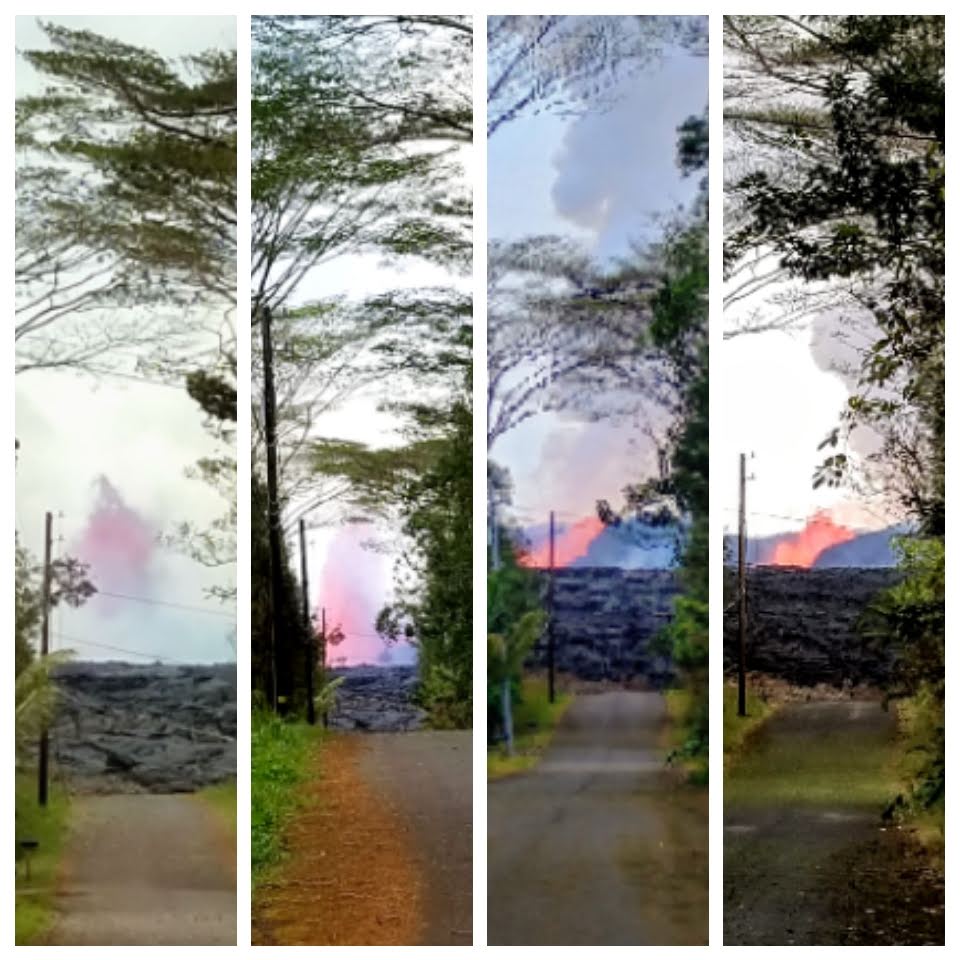
Fissure 8 progression during the 2018 Kilauea eruption, seen from Luana Street. PC: Crystal Richard.
Big Island residents and visitors are invited to come to support Pāhoa Town businesses, entrepreneurs and tastemakers at Activate Puna on Saturday, May 11, along Mainstreet Pāhoa from 4 to 10 p.m., featuring two stages of entertainment, art installations, mural unveils, creative and food pop-ups.
Activate Puna is a community revitalization and pono placemaking project that brings people together for enriching experiences. The event is open to all. A $5 suggested donation for those 13 and older is welcomed; keiki 12 and under are free. Proceeds go to organizations that uplift the Puna community. Bring your own beach chairs to sit and enjoy the music.
Big Island Now will provide an update on recovery efforts from Hawai‘i County Mayor Harry Kim on Thursday, May 9, 2019.
RELATED LINK



